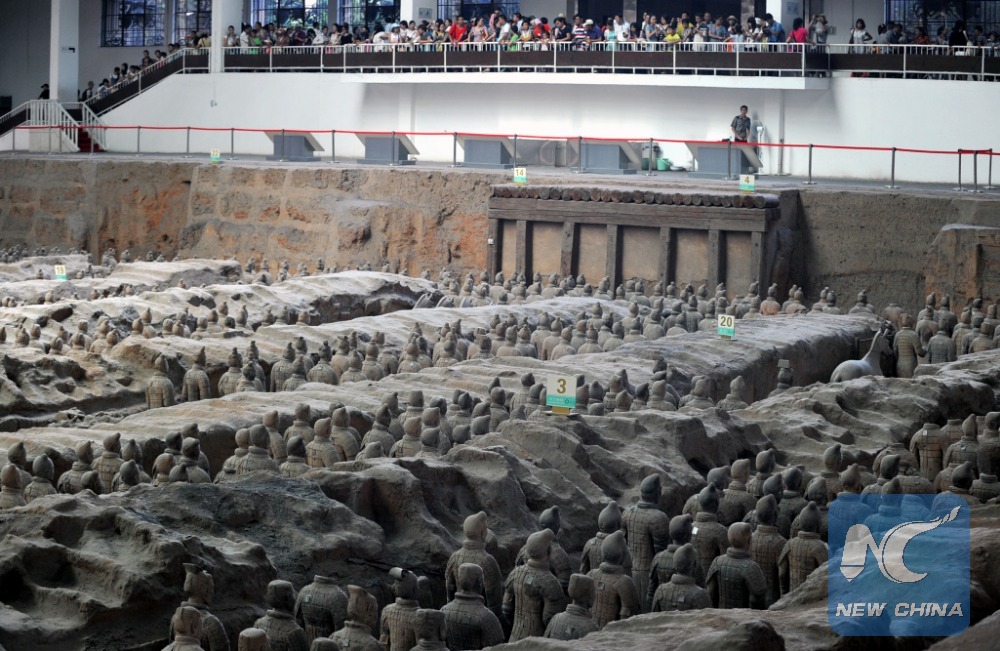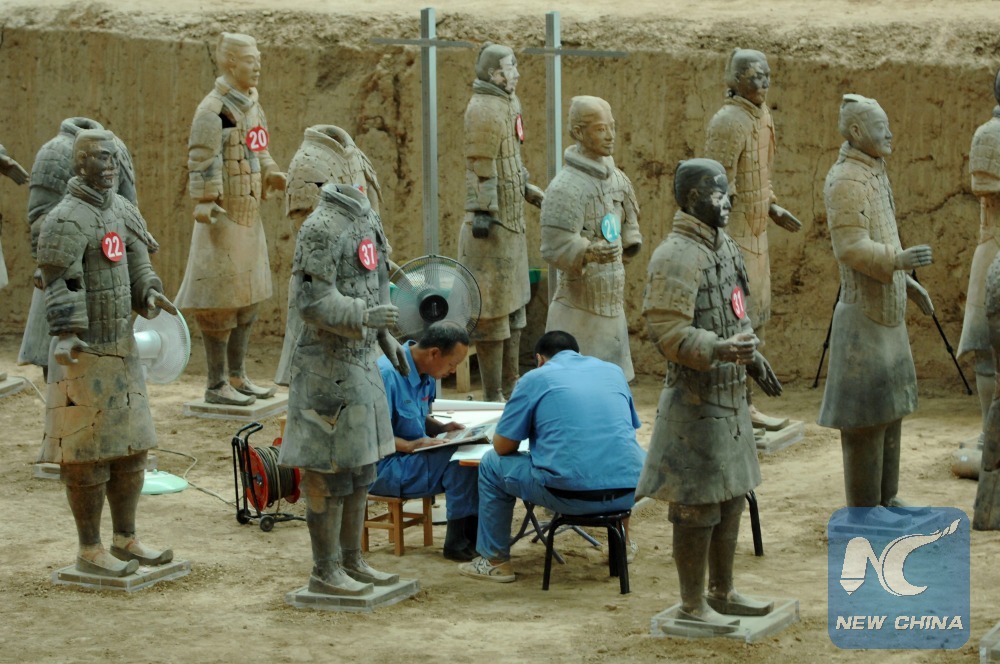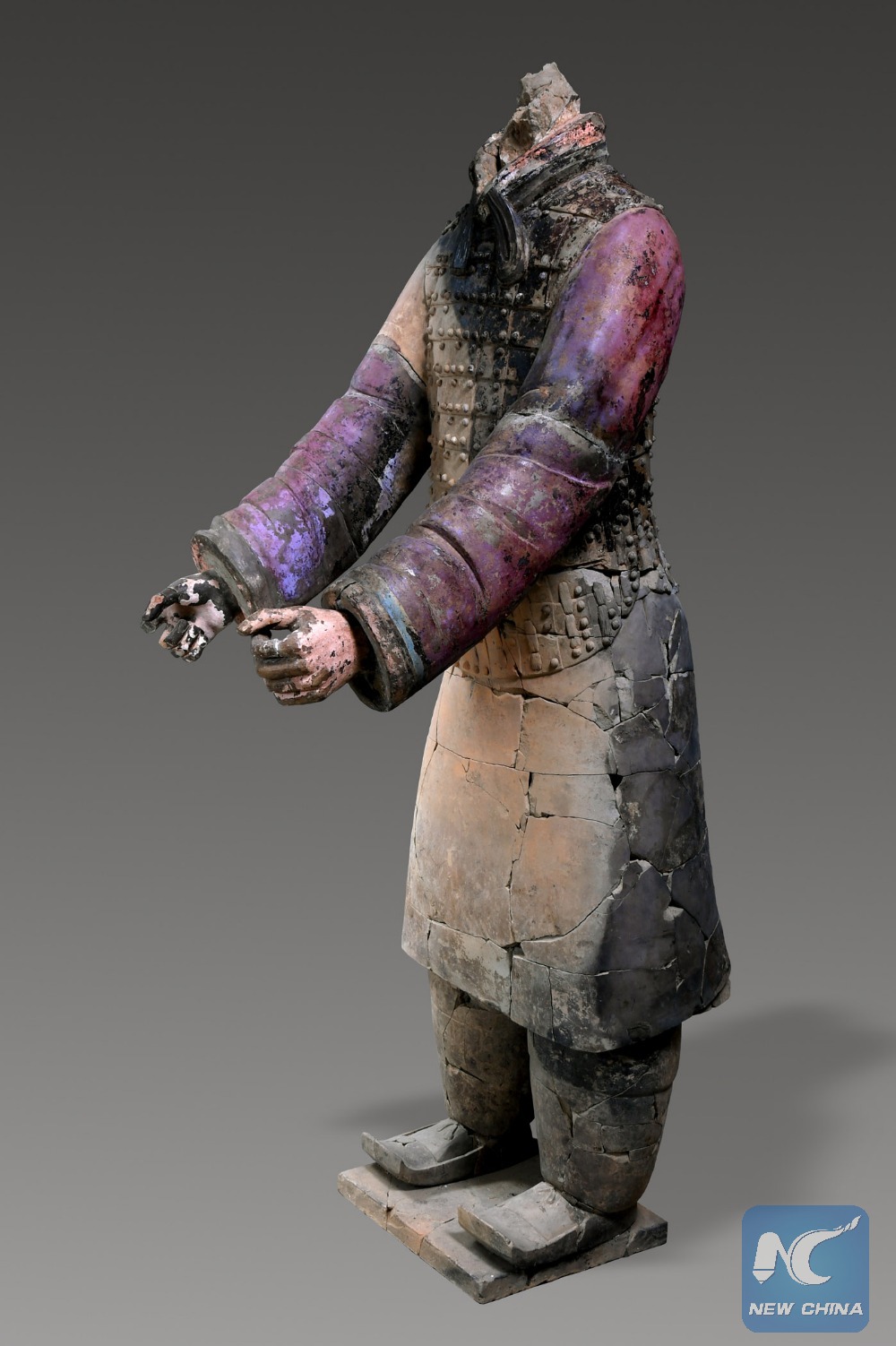
Tourists visit the terracotta warriors and horses at the Emperor Qinshihuang's Mausoleum Site Museum in Xi'an, capital of northwest China's Shaanxi Province. (Xinhua/Chen Haining)
45 years after they were discovered by some farmers by accident, the 2,200-year-old Terracotta Army still has mysteries to be uncovered. We have recently collected questions about the army from our followers on Twitter and Facebook, and invited experts from the Emperor Qinshihuang's Mausoleum Site Museum to answer.

Buried 40 km from downtown Xi'an, northwest China's Shaanxi Province, these vivid, life-sized figures were all molded from clay (no bones) as funerary objects for Emperor Qinshihuang of the Qin Dynasty around 200 BC. No two figures in the army are alike. Each of the statues has a different facial expression and hairstyle, and craftsmen are believed to have modeled them after real men.

To make a terracotta warrior, the body was molded first and then the arms and the legs, and, finally the head. Then these parts were put together. For some figures, their top halves are hollow and the lower halves are solid. It depends on how large the piece is.

There are three terracotta pits in the museum. Pit No.1 is the biggest, with about 6,000 terracotta warriors inside. Pit No.2 is smaller, with around 1,400 and Pit No.3 is the smallest and with only 68 terracotta warriors. So in the three pits, there are over 8,000 terracotta figures.
But there are more areas that have yet to be excavated: What you see today in the three pits is just a small piece of the puzzle, hundreds of pits are still buried. According to historical records, 720,000 workers labored 38 years to build the mausoleum for the emperor.

Archaeologists work at the No. 1 pit. (Xinhua/Li Yibo)

The army is traditionally believed to have been created to protect Emperor Qinshihuang in his afterlife. Apart from soldiers, figures representing officials and performers were also found in the army. Qinshihuang is known for unifying China as we know it for the first time, becoming the first emperor in Chinese history, and founding the Qin Dynasty.

The figures stand at an average height of 190 cm, much taller than Chinese people would have been at the time, or even today. The age of the warriors is unclear, although the figures are thought to have been modeled on real men.

More than 40,000 pieces of various weapon relics have been uncovered -- bronze daggers, spears, swords, arrows, crossbows and so on.
All these weapons were metal, many with wooden handles. After being buried for centuries, much of wooden parts of the weapons have decayed, bronze parts have lasted well, with many of the weapons are still shiny, with almost pristine surfaces and sharp blades.

So far no female figures have been confirmed. Although the gender of the horses are unclear!

Four minutes. Just four minutes is all it takes for the rarest colors on earth to fade in front of your eyes.
Almost every warrior and horse was painted, but after more than 2,200 years buried underground, the pigments began to change just 15 seconds after they were unearthed, and within four minutes the lacquer layers that were bound with the pigments broke away.
Before the artifacts were unearthed, they were protected by a cooler and more humid underground environment. But when they were first discovered in 1974, there were no advanced techniques to properly protect the warriors. Photographers did not have time to take records before the paint began to disappear.
For the last 20 years, Chinese researchers have collaborated with foreign scholars to find ways to preserve colors on pottery.
An antiseptic substance is now applied to the layers once the warriors are unearthed, and they are then wrapped in plastic membranes to keep them humid while skilled workers clean the surface and work on them in labs.
These new techniques can keep the paint stable for over ten years. And in the museum you can see for yourselves the scarlet hair bands, pink faces, scarlet lips, purple robes and pants of some of the well-preserved warriors.

A repaired warrior (Xinhua/Zhang Tianzhu)

In fact, the debate on whether to unearth the emperor's tomb or not has been going on for decades. As the mausoleum has remained untouched by grave robbers, many believe it would be of great value to the study of ancient Chinese history if it were excavated.
Archaeologists have used remote sensing equipment to find symmetrical staircases and wooden structures inside the mausoleum. They have also discovered that the mausoleum was built with an effective drainage system that has prevented ground water from seeping inside.
Legend has it that a huge underground palace was modeled on the emperor's realm with rivers flowing with mercury and a ceiling studded with pearls and diamonds representing the stars and sun.
But the government has repeatedly reaffirmed that it has no plans to unearth the mausoleum for fear of damage. Current techniques cannot ensure that the mausoleum will be properly protected after excavation, so until advanced techniques can be developed to ensure the area can be safely uncovered, the mausoleum will remain undisturbed.
With an area of 60 square kilometers, the mausoleum is a huge complex. The first formal excavation of the site lasted for six years from 1978 to 1984 and uncovered 1,087 clay figures. A second excavation, in 1985, lasted a year but was cut short for technical reasons.
In the three pits, conservation and restoration work has been ongoing for 40 years. Work on some 1,000 figures has only just been completed recently.

